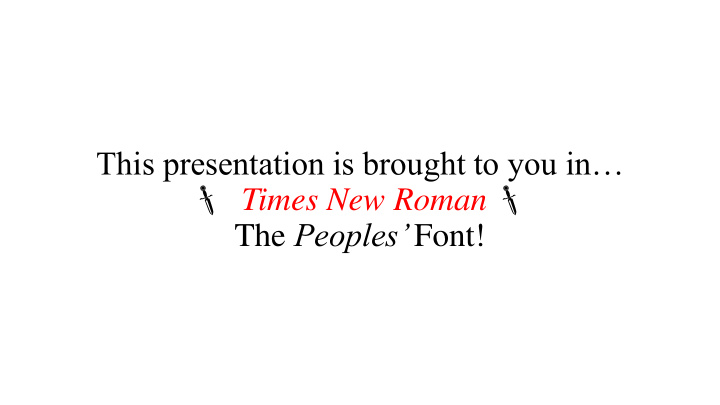



This presentation is brought to you in… Times New Roman The Peoples’ Font!
Two Cheers for Ancient Rome!! A Christian Reappraisal of the Evil Empire… Fall, 2017, Eric Wright, Ann Arbor Christian Reformed Church
Fourth Session: - Introduction to Roman culture, historical approach, general questions and issues. (October 15, 2017). - Rome in its Historical context. (October 22, 2017). - Christianity in the Roman world. (October 29, 2017). - Further questions and our current assessment of ancient Rome! (November 5, 2017).
Further questions and our current assessment of ancient Rome! (November 5, 2017).
Today’s agenda : I. Roman Battle II. Beard summing up ancient Rome III. “Libertas” IV. Contributions of Rome Toward a Theological Critique of Roman – or any – V. Power Structure VI. Migration per Romani VII.Final Defense VIII. Three reasons for Rome’s “Fall” IX. Quiz 2 nd Monty Python Skit X.
“The truth is that empire has been the world’s most common form of political organization for the last 2,500 years. Most humans during these two and a half millennia have lived in empires. Empire is also a very stable form of government. Most empires have found it alarmingly easy to put down rebellions. In general, they have been toppled only by external invasion or by a split within the ruling elite. – Yuval Noah Harari “Rome ‘fell’ longer than most empires existed.” – Brian Ward-Perkins
A Procession of Particulars …
https://www.youtube.com/w atch?v=pJO2UfG9KcI [1:40 mins.] Battle with Gauls
https://www.youtube.com/w atch?v=2k448JqQyj8 Boris Johnson and Mary Beard (Greece vs. Rome)
Rome, the first western political entity to seriously struggle with the balance of individual liberty in the context of the larger political structure, (“ libertas .”)
200 years of Roman peace, a span not equaled in the west until 40 years prior to WWI.
Rome’s fundamental genius: “Letting people become what they weren’t.” – (Beard)
Biblical judgements aimed specifically at Rome: From… N.T. Wright’s podcast, “Revelation and Hope: Political Implications in the Revelation of John.” (What the Bible says specifically about empire, power, and Roman power, specifically.) KEY POINTS: • The political message and challenge of Revelation is that Christ is already Lord of Lords, that the Kingdom is already here. • Heaven and Earth interlock – not divided by a huge gulf; a “Heaven/Earth overlap,” exists, the twin halves of God’s Creation. • John, Chs. 18 – 19 are N.T. Wright’s center of political theology.
“The Kingdom of the world has become the Kingdom of our Lord and Messiah.” – Rev. 11:15
“You (Pilate) have no authority over me except what has been given you from Heaven.” – JN. 19:11
https://www.youtube.com/w atch?v=0IzTpzpayy4 What can Rome teach us about the migrant crisis? (Beard)
Rome was not simply the thuggish younger sibling of classical Greece! (Also)… Rome had no grand plan of world conquest.
Interesting point: Scipio Aemilianus’s conquest of Spanish Numantia, a national identity story in Spain, is remembered in a romance language, in Latin script, a story of freedom-loving barbarians co-opting the very memory of the vanquished. (Harari) It was the Romans who remembered and admired the Numantians, who they nevertheless annihilated for their rebellion.
Ancient Romans had a tendency to blame the accidents of history on transgressive female behavior; (women were slightly “dangerous.”) (Beard.) Livia Drusilla, Wife of Augustus Agrippina the Younger, Cleopatra i Mother of Nero
THREE possibilities with Rome’s fall: 1.) a long slow decline; 2.) a series of patchy, cultural and political changes morphing into early medieval period; 3.) “late antiquity” itself was actually a time of dynamic art and architecture. (Brian Ward-Perkins argues, contrary to Francis Schaeffer [“decadence”] that Rome’s decline was extraordinarily violent, due to invasions by “Romanized” barbarians).
According to some historians, Rome’s fall was due to a crisis of constitution and succession, and also one of increased soldiers’ allegiances to generals (instead of the greater good of the nation).
Other explanations for Rome’s fall: the “Augustan” model was replaced by distance emperors; a severe plague at the end of the 1 st Century significantly decreased the population ; and many, many other theories, too… [A handout elucidating many of these is available after this session!]
Final, multiple choice question: Which of the following books is the international best selling work from the ancient world (other than the Bible…) A.) The Iliad and the Odyssey, (Homer) B.) The Metamorphoses, (Ovid) C.) Lives, (Plutarch) D.) How I *Could* Have Won the Battle of Actium if it Weren’t for that Harridan, Cleopatra! (Mark Antony)
Trick Question !
The Aeneid…
…and Caesar’s, Battle for Gaul “Caesar had no shield with him - and went forward to the front line, where he called out to all the centurions by name and shouted encouragement to the rest of the men, whom he ordered to advance and to open out their ranks so that they could use their swords more effectively.”
https://www.youtube.com/watch?v=vsawP_Ew0r4 [1:50 mins.] Romane ite Domum!
Bib iblio liography, , Notes, , and PowerPoint Soon Avail ilable on Church Sit ite!
Including theories on why the Roman Republic fell… http://web.ics.purdue.edu/~rauhn/fall_of_republic.htm
And why the Empire Fell, too …
Fin, Session 4 (of IV)
Recommend
More recommend